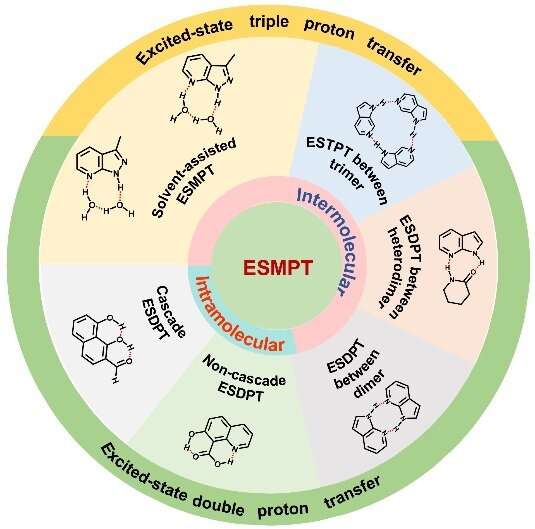Recent progress on the excited-state multiple proton transfer process in organic molecules

In a recent study, researchers systematically introduced excited-state multiple proton transfers (ESMPTs) in organic molecules. Although great advances have been achieved, there is still much controversy regarding the mechanism of ESMPT in organic molecules. From a large number of experimental studies conducted so far, it is difficult to draw firm conclusions about the origin of spectral features, the occurrence and mechanism of ESMPT using only one method.
More reliable results can be obtained by combining different methods, such as spectroscopy studies, reaction dynamics analysis, and theoretical calculations.
In addition, studies focusing on the application of ESMPT-active materials are relatively rare. In theory, the inherent multilevel system in ESMPT-active materials can facilitate population inversion and thus enable simulated emissions. Because the emission bandgap can be further narrowed by multiple proton transfers compared with a single proton transfer, ESMPT-active materials may be an excellent choice for achieving near-infrared organic lasers with longer emission wavelengths.
In addition, since some ESIPT-active materials have achieved a high photoluminescence quantum yield in the liquid crystal (LC) phase, they may exhibit more promising prospects in light-emitting self-luminous LC devices. Moreover, owing to their multi-emission properties, ESMPT-active materials have shown great potential for the use as molecular probes.
In the research, published in Science China Chemistry, the author notes that the study of the ESMPT not only deepens understanding of molecular dynamics but also provides opportunities for new applications. This review will help relevant researchers deepen their understanding of this field, thereby promoting its development.
More information: Wan-Ying Yang et al, Recent progress on the excited-state multiple proton transfer process in organic molecules, Science China Chemistry (2022). DOI: 10.1007/s11426-022-1375-y
Provided by Science China Press





















